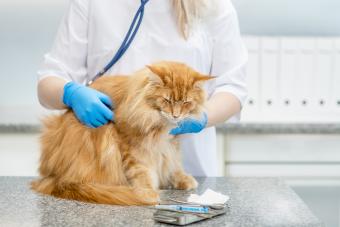
If you encounter your cat throwing up worms, it's almost certain they have roundworms. The challenge is to treat them before your other pets, and perhaps even your family, become infected.
How Cats Get Roundworms
It's not uncommon to see worms in cat vomit. Roundworms are a common parasite that can infect people and dogs, as well as cats. The roundworm eggs and larvae are found in the following places:
- Kitty litter
- Feces
- Vomit
- Dirt
- A mother cat's milk
How Cats Are Infected With Roundworms
According to Mar Vista Animal Medical Center, your pet may have become infested in any of the following ways:
- Kittens can contract roundworms by nursing from an infected mother.
- Worm ova can be ingested when a cat uses contaminated kitty litter then cleans their paws while grooming.
- Eating rodents that have roundworms is another way to acquire an infestation.
- Ingesting infected feces will also lead to a case of roundworms.
Signs of Roundworm Infestation in Cats

Roundworms are generally between 3 and 6 inches long, and they live in the intestinal tract of your pet. They are a very common parasite that can be identified by their white to cream-colored, thread-like bodies. In addition to throwing up the roundworms, you can also be relatively sure your pet has them if they display the following signs:
- Increase in appetite
- Sluggish behavior
- Lack of self-grooming
- Diarrhea
- Dull hair
- Pot-bellied appearance
Roundworms in Cats Pictures
Below is a video in which you can see what round worms look like in a cat that has vomited.
Treating Your Cat for Roundworms
Treating your cat for roundworms is as simple as giving them a pill. Follow your veterinarian's directions carefully and be sure that your pet gets all of their medication.
Medications Used for Roundworms
According to Mar Vista Animal Medical Center, medications used to eliminate roundworms in cats include:
- Drontal
- Panacur
- Pyrantel
- Revolution
- Centragard
- Bravecto Plus
- Advantage Multi
Some of these medications are topical and can easily be administered on your cat's skin between their shoulders, whereas others are pills that must be given orally.
Dosing Your Cat
Giving a cat a pill can be difficult, but not impossible. When you're giving your cat pills, try the following:
- Hold the cat firmly but gently in your lap.
- Gently tilt their head backwards and open their jaw with your forefinger.
- Place the pill as far back on their tongue as you can.
- Holding their mouth closed, allow them to return their head to a comfortable position.
- Carefully stroke their throat downward until they swallow.
Your vet will probably give you instructions for dealing with any other pets in your home and will likely want to give them worming medication as well. You may be asked to keep your cat, and their kitty litter, separate from any other cats for a time to prevent transmission.
Preventing Further Roundworm Infestations in Cats
To prevent further infestations, consider the following tips:
- Clean the litter regularly.
- Keep new cats separated from the rest of your cats until you can have them checked for worms.
- Do not allow your pets to hunt.
- Keep fleas controlled.
- Have your pets examined on a regular basis.
- Follow your veterinarian's instructions carefully.
Seek Help from Your Vet and Your Physician for Roundworms in Cats
If you notice spaghetti-like strands in your cat's vomit, be sure to call your vet immediately. If you also have children, it is a good idea to have their pediatrician check them for signs of roundworms as well. Although it is rare for these worms to be transmitted to children, it can happen. Roundworms can produce serious side effects in humans.







